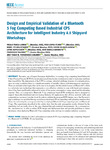Mostrar o rexistro simple do ítem
Design and Empirical Validation of a Bluetooth 5 Fog Computing Based Industrial CPS Architecture for Intelligent Industry 4.0 Shipyard Workshops
| dc.contributor.author | Fraga-Lamas, Paula | |
| dc.contributor.author | López Iturri, Peio | |
| dc.contributor.author | Celaya-Echarri, Mikel | |
| dc.contributor.author | Blanco, Óscar | |
| dc.contributor.author | Azpilicueta, Leyre | |
| dc.contributor.author | Varela-Barbeito, José | |
| dc.contributor.author | Falcone, Francisco | |
| dc.contributor.author | Fernández-Caramés, Tiago M. | |
| dc.date.accessioned | 2020-03-31T14:54:22Z | |
| dc.date.available | 2020-03-31T14:54:22Z | |
| dc.date.issued | 2020-03-04 | |
| dc.identifier.citation | P. Fraga-Lamas et al., "Design and Empirical Validation of a Bluetooth 5 Fog Computing Based Industrial CPS Architecture for Intelligent Industry 4.0 Shipyard Workshops," in IEEE Access, vol. 8, pp. 45496-45511, 2020. | es_ES |
| dc.identifier.issn | 2169-3536 | |
| dc.identifier.uri | http://hdl.handle.net/2183/25281 | |
| dc.description.abstract | [Abstract] Navantia, one of largest European shipbuilders, is creating a fog computing based Industrial Cyber-Physical System (ICPS) for monitoring in real-time its pipe workshops in order to track pipes and keep their traceability. The deployment of the ICPS is a unique industrial challenge in terms of communications, since in a pipe workshop there is a significant number of metallic objects with heterogeneous typologies. There are multiple technologies that can be used to track pipes, but this article focuses on Bluetooth 5, which is a relatively new technology that represents a cost-effective solution to cope with harsh environments, since it has been significantly enhanced in terms of low power consumption, range, speed and broadcasting capacity. Thus, it is proposed a Bluetooth 5 fog computing based ICPS architecture that is designed to support physically-distributed and low-latency Industry 4.0 applications that off-load network traffic and computational resources from the cloud. In order to validate the proposed ICPS design, one of the Navantia’s pipe workshops was modeled through an in-house developed 3D-ray launching radio planning simulator that allows for estimating the coverage provided by the deployed Bluetooth 5 fog computing nodes and Bluetooth 5 tags. The experiments described in this article show that the radio propagation results obtained by the simulation tool are really close to the ones obtained through empirical measurements. As a consequence, the simulation tool is able to reduce ICPS design and deployment time and provide guidelines to future developers when deploying Bluetooth 5 fog computing nodes and tags in complex industrial scenarios. | es_ES |
| dc.description.sponsorship | Auto-ID for Intelligent Products research line of the Navantia-UDC Joint Research Unit (Grant Number: IN853B-2018/02) 10.13039/100014440-Ministerio de Ciencia, Innovaci??n y Universidades (Grant Number: RTI2018-095499-B-C31) | es_ES |
| dc.language.iso | eng | es_ES |
| dc.publisher | Institute of Electrical and Electronics Engineers | es_ES |
| dc.relation | info:eu-repo/grantAgreement/AEI/Plan Estatal de Investigación Científica y Técnica y de Innovación 2017-2020/RTI2018-095499-B-C31/ES/IMPLEMENTACION DE ENTORNOS CONTEXTUALES INTERACTIVOS, CONECTADOS Y SEGUROS PARA EL TRANSPORTE FERROVIARIO DE PASAJEROS APOYADOS EN LA IOT Y TECNICAS DE SOFT COMPUTING | |
| dc.relation | info:eu-repo/grantAgreement/AEI/Plan Estatal de Investigación Científica y Técnica y de Innovación 2017-2020/RTI2018-095499-B-C31/ES/IMPLEMENTACION DE ENTORNOS CONTEXTUALES INTERACTIVOS, CONECTADOS Y SEGUROS PARA EL TRANSPORTE FERROVIARIO DE PASAJEROS APOYADOS EN LA IOT Y TECNICAS DE SOFT COMPUTING | |
| dc.relation.uri | https://doi.org/10.1109/ACCESS.2020.2978291 | es_ES |
| dc.rights | Atribución 4.0 Internacional (CC BY 4.0) | |
| dc.rights | Atribución 4.0 Internacional (CC BY 4.0) | |
| dc.rights.uri | https://creativecommons.org/licenses/by/4.0/ | |
| dc.rights.uri | https://creativecommons.org/licenses/by/4.0/ | |
| dc.subject | Industry 4.0 | es_ES |
| dc.subject | IIoT | es_ES |
| dc.subject | Cyber-physical system | es_ES |
| dc.subject | ICPS | es_ES |
| dc.subject | Fog computing | es_ES |
| dc.subject | Edge computing | es_ES |
| dc.subject | Shipyard 4.0 | es_ES |
| dc.subject | Bluetooth 5 | es_ES |
| dc.subject | LP-WAN | es_ES |
| dc.subject | 3D ray launching | es_ES |
| dc.title | Design and Empirical Validation of a Bluetooth 5 Fog Computing Based Industrial CPS Architecture for Intelligent Industry 4.0 Shipyard Workshops | es_ES |
| dc.type | info:eu-repo/semantics/article | es_ES |
| dc.rights.access | info:eu-repo/semantics/openAccess | es_ES |
| UDC.journalTitle | IEEE Access | es_ES |
| UDC.volume | 8 | es_ES |
| UDC.startPage | 45496 | es_ES |
| UDC.endPage | 45511 | es_ES |
| dc.identifier.doi | 10.1109/ACCESS.2020.2978291 |
Ficheiros no ítem
Este ítem aparece na(s) seguinte(s) colección(s)
-
GI-GTEC - Artigos [193]






